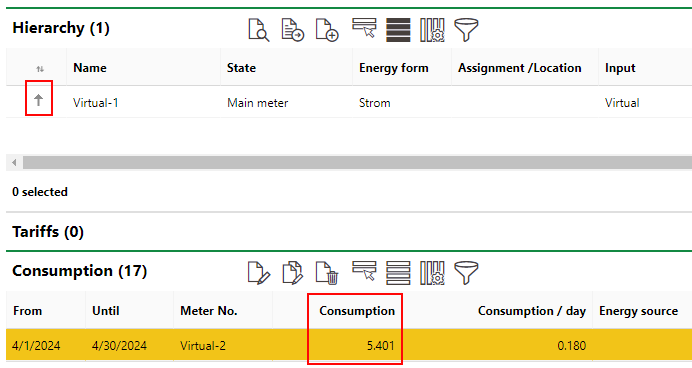A virtual metering point is one whose consumption entries reflect the consumption recorded at other metering points in its hierarchy. A virtual metering point does not directly record energy consumption itself. For example, you could set up a virtual metering point whose entries in the Consumption section reflect the sum of the energy consumed at multiple metering points directly beneath it in its hierarchy.
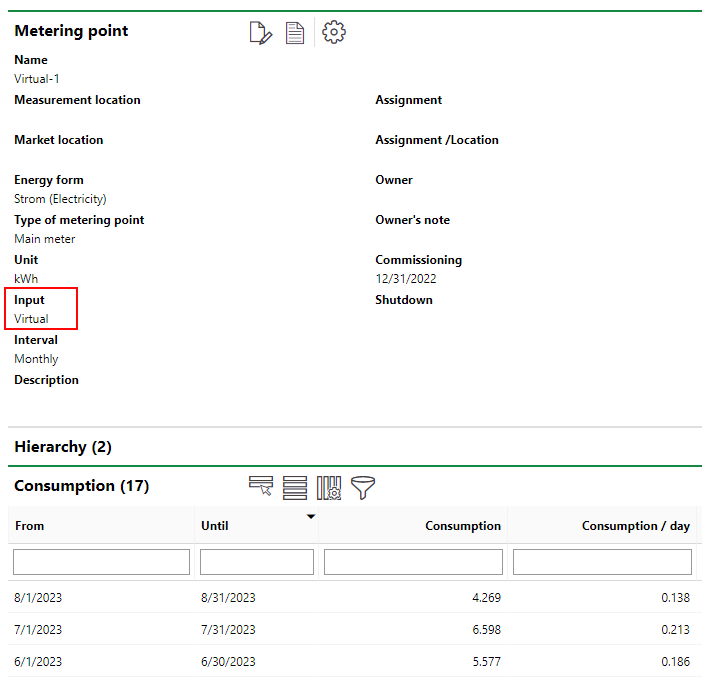
Metering Point with Virtual Selected as Input
Virtual metering points and some metering point in a hierarchy with a virtual metering point have an additional column in their Consumption section called Direct Consumption. This is separate from the actual Consumption and refers to the Consumption after the calculations are applied by the virtual metering point. Direct Consumption values for different types of virtual metering point hierarchies are explained in the sections below.

Direct Consumption Column
When you set a metering point's Input property to Virtual in its metering point details, a Virtual section becomes available on the metering point details page.

Virtual Section on the Metering Point Details Page
Click the Add (![]() ) icon to create a new entry in the Virtual section.
) icon to create a new entry in the Virtual section.
Virtual Types
When you create a new entry, you need to specify the date from which the logic in the entry should be enforced and select one of the Types below.
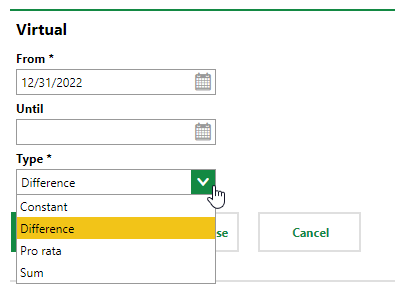
Virtual Types
You cannot have multiple entries with different Type properties at the same time. Only one entry needs to exist at a time.
The virtual metering point's place in a hierarchy varies based on the Type of the entry created in the Virtual section on the virtual metering point's details page. In a Difference or Sum hierarchy, the virtual metering point must be a main metering point atop its hierarchy. In a Constant or Pro Rata hierarchy, the virtual metering point must be below a superior metering point whose Input property is Meter Readings or Consumption.
Virtual Types
Type |
Description |
||||
|---|---|---|---|---|---|
In a metering point hierarchy, the virtual metering point is placed directly beneath a metering point whose Input is Meter Readings or Consumption. The number specified in the Virtual entry on the virtual metering point is reported as the virtual metering point's consumption each interval period (e.g., each month) and subtracted from the superior metering point's consumption to yield its Direct Consumption.
|
|||||
Consumption entries from subordinate metering points in the metering point's hierarchy are subtracted from the consumption of the metering point directly beneath the virtual metering point. The difference is reflected in the Direct Consumption column in the Consumption section for the metering point directly beneath the virtual metering point, and as the Consumption for the virtual metering point. A hierarchy of three levels is required, and the virtual metering point must be the superior metering point (at the top of the hierarchy). |
|||||
In a metering point hierarchy, the virtual metering point is placed directly beneath a metering point whose Input is Meter Readings or Consumption. A percentage is specified in the Virtual entry for the virtual metering point, and this percentage of the superior metering point's consumption is calculated to determine the virtual metering point's consumption.
|
|||||
Consumption entries from subordinate metering points in the metering point's hierarchy are totaled and reflected in the Consumption section for the virtual metering point. The virtual metering point must be above the subordinate metering points whose consumption values are being tallied in the hierarchy. |
Ensure you select the correct date in From field when you create a new Virtual entry. Consumption data from before the date specified in the From field cannot be incorporated into the consumption data for the virtual metering point.
All metering points in a virtual metering point's hierarchy should have the same Energy Form and Unit in the metering point details.
Refer below for examples of how to set up the different Virtual consumption types in VertiGIS FM.
Constant
A virtual metering point with a Type of Constant is assigned a number in its virtual entry on the metering point details page. This number is reported as the virtual metering point's consumption each period, and subtracted from the superior metering point's Consumption to yield its Direct Consumption.
For a virtual metering point that uses Constant, you must place the metering point directly beneath the metering point whose consumption you want to subtract from in the hierarchy.

Strand Diagram for Constant Virtual Metering Point
On the details page for the virtual metering point, create a Virtual entry with a Type property of Constant. The entry must specify the recurring consumption for the virtual metering point and the number you will subtract from its superior metering point's consumption each period. You can enter a factor if you want to multiply the number entered in the Consumption [unit] box.
In this example, the virtual entry has a Consumption of 200 kWh, and a Factor of 1, meaning it is not multiplied.
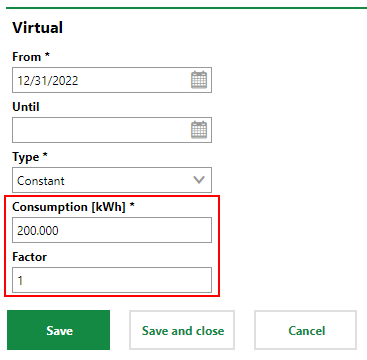
Constant Virtual Entry
This number is reported as the virtual metering point's each period (in this example, each month).
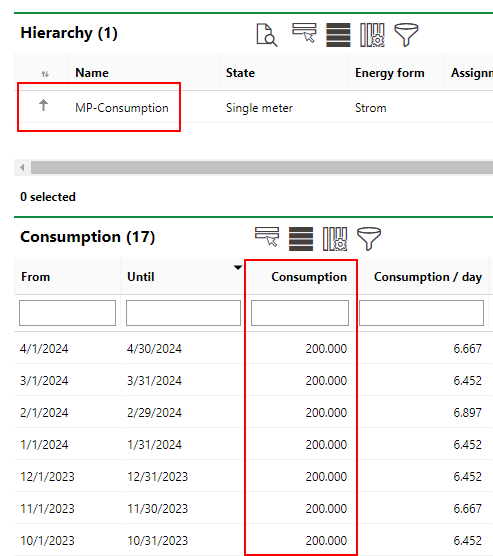
Consumption for Virtual Metering Point with Constant Virtual Type
The metering point point above the virtual metering point in the hierarchy ("MP-Consumption") has a Direct Consumption that is its own Consumption for the period, minus 200. In April 2024, for example, its Consumption was 1,000 kWh, making its Direct Consumption 800 kWh.

Consumption and Direct Consumption for Metering Point Above Constant Virtual Metering Point
If you were to change the Factor in the Virtual entry to 2, the virtual metering point's consumption and the amount subtracted from the superior metering point's consumption would double.
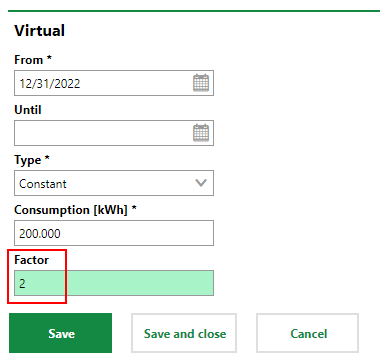
Virtual Entry Factor
The virtual metering point 's Consumption for the period is now 400 kWh, and the superior metering point's Direction Consumption is its own Consumption minus 400.

Consumption and Direct Consumption for Metering Point Above Constant Virtual Metering Point with Doubled Factor
This logic is demonstrated by the diagram below.
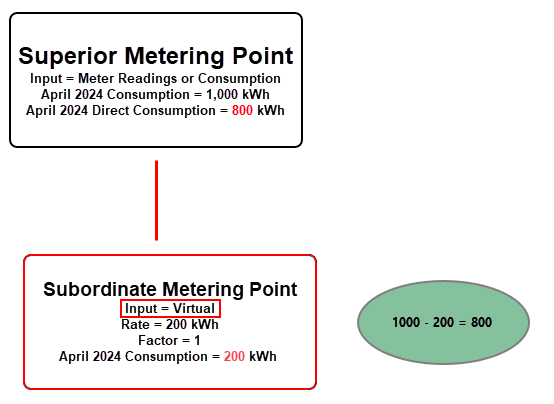
Diagram Demonstrating Logic for Constant Virtual Metering Point
Difference
When you create a Virtual entry with Difference selected as the Type, VertiGIS FM calculates the difference between two subordinate metering points in the hierarchy and reports it as the Consumption for the virtual metering point.
Virtual metering points that have a Type of Difference must be structured atop a hierarchy like the one shown in the strand diagram image below. The consumption of the metering point at the bottom of the hierarchy ("MP-Readings") is subtracted from the consumption of the metering point directly beneath the virtual metering point ("MP-Consumption"). A three-tiered hierarchy is required so that VertiGIS FM knows which metering point's consumption to subtract and which metering point's consumption it is subtracting from.

Strand Diagram for Virtual Metering Point with Difference
The Strand Diagram is a helpful tool for visualizing hierarchies when structuring metering points for virtual consumption.
VertiGIS FM calculates the difference in energy consumption by subtracting the consumption of the lowest secondary metering point in the hierarchy ("MP-Readings", 5.401 kWh) from the one directly beneath the virtual metering point ("MP-Consumption", 5.500 kWh). The difference (or Direct Consumption) is shown in the Consumption section on the metering point details page for the subordinate metering point that is directly beneath the virtual metering point in the hierarchy. In this example, the Direct Consumption is 0.099 kWh (5.500-5.401).
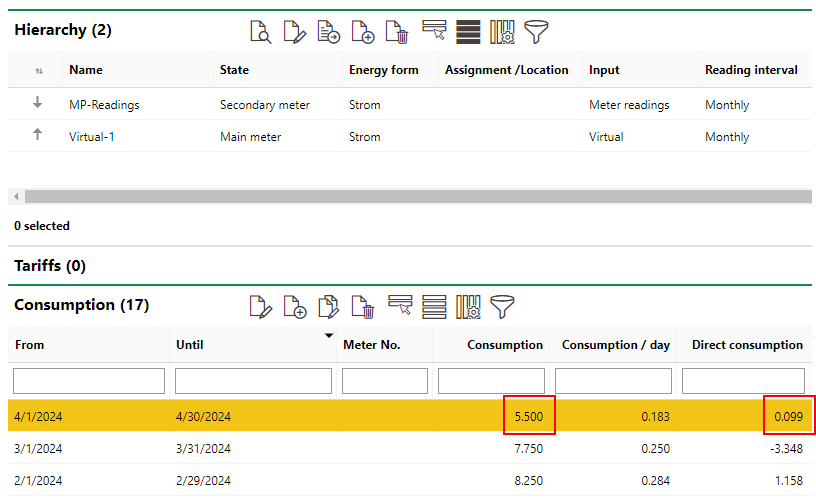
Consumption for Metering Point Directly Beneath Virtual Metering Point
The Direct Consumption calculated on the metering point directly beneath the virtual metering point (0.099 kWh) is inherited by the virtual metering point as its Consumption.
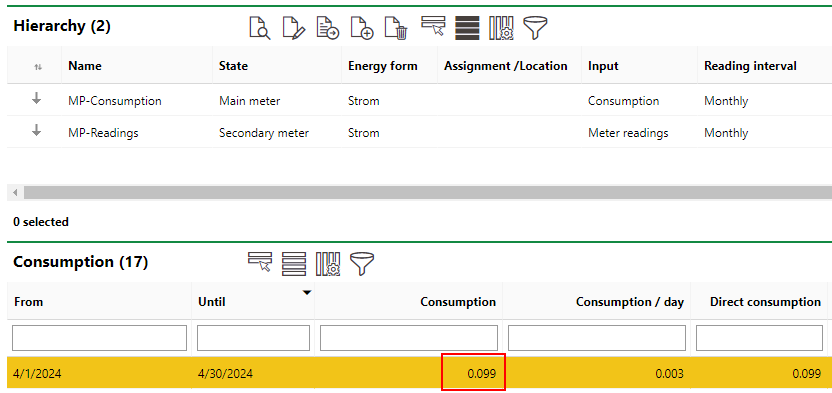
Consumption for Virtual Metering Point
The logic in this example is represented in the diagram below.

Diagram Demonstrating Difference Logic for Virtual Metering Points
You can add additional metering points to hierarchies accordingly. If you add another metering point to the lowest level in the hierarchy pictured above, its consumption is included in the amount subtracted from the consumption of the metering point above directly beneath the virtual metering point.
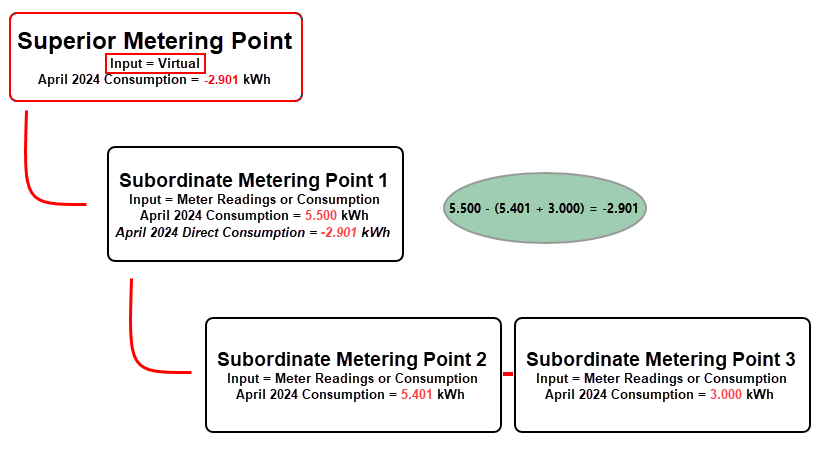
Diagram Demonstration Difference Logic for Virtual Metering Points with Second Metering Point on Lowest Level
The Direction Consumption for the metering point directly beneath the virtual metering point and the Consumption of the virtual metering point update accordingly. Because the two metering points beneath it in the hierarchy had a higher combined energy consumption (5.401 + 3.000) than its own consumption (5.500), its Direct Consumption value is negative.
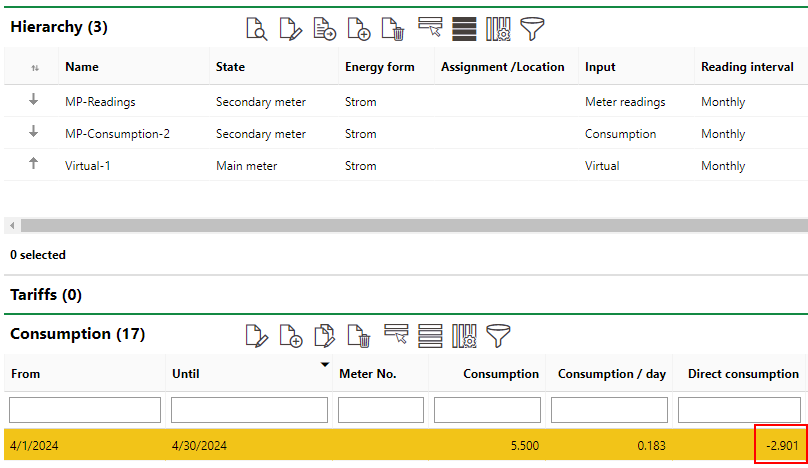
Updated Direct Consumption with Second Subordinate Metering Point
Pro Rata
A virtual metering point with a Type of Pro Rata is used to calculate a percentage of the consumption of a metering point whose Input method is Meter Readings or Consumption. When you specify a virtual Type of Pro Rata, you must place the metering point directly beneath the metering point whose consumption you want to calculate a percentage of in the hierarchy.

Strand Diagram for Pro Rata Virtual Metering Point
On the details page for the virtual metering point, create Virtual entry with a Type property of Pro Rata. The entry must specify the percentage of the superior metering point's consumption you want to calculate. In this example, the virtual entry has a Consumption [%] of 20%.

Pro Rata Virtual Entry
The metering point point above the virtual metering point in the hierarchy ("MP-Consumption") has a consumption of 1,000 kWh for January 2024.

Consumption for Metering Point Superior to Virtual Metering Point in Hierarchy
On the details page for the virtual metering point, the consumption for January 2024 is 200 kWh, or 20% of the consumption of its superior metering point for January 2024.
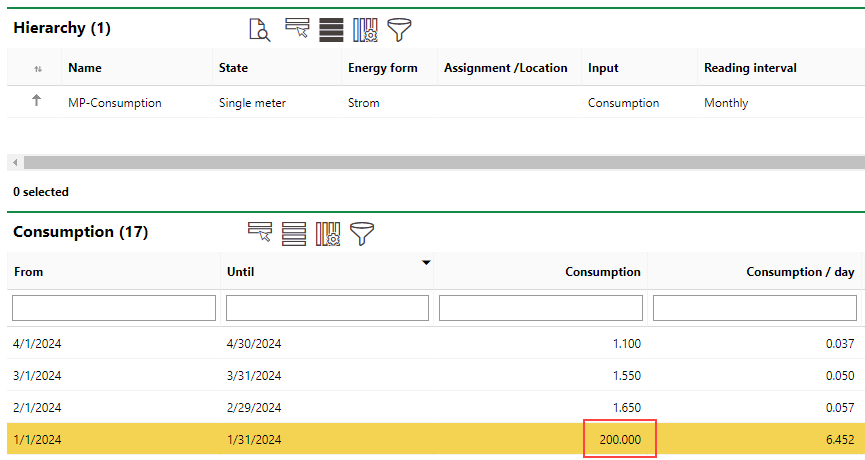
Consumption for Virtual Point in Hierarchy
The logic in this example is represented in the diagram below.
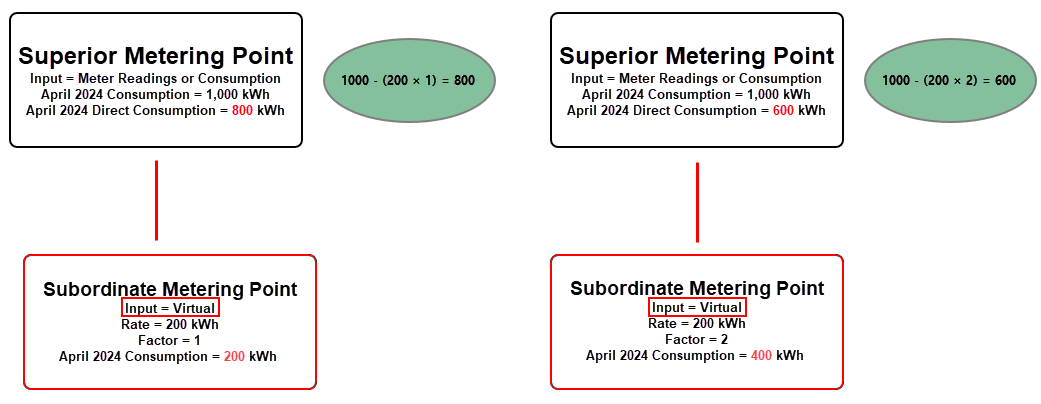
Diagram Demonstrating Logic for Pro Rata Virtual Metering Points
Sum
When you create a Virtual entry with Sum selected as the Type, entries in the Consumption section on the details page of the virtual metering point reflect the sum of energy consumed by metering points directly beneath it in the hierarchy.

Strand Diagram Showing Virtual Metering Point Hierarchy for Sum
For example, the virtual metering point shown below has two subordinate metering points whose Input methods are Meter Readings and Consumption, respectively. The Consumption section for the virtual metering point indicates a consumption of 10.901 kWh for April 2024.
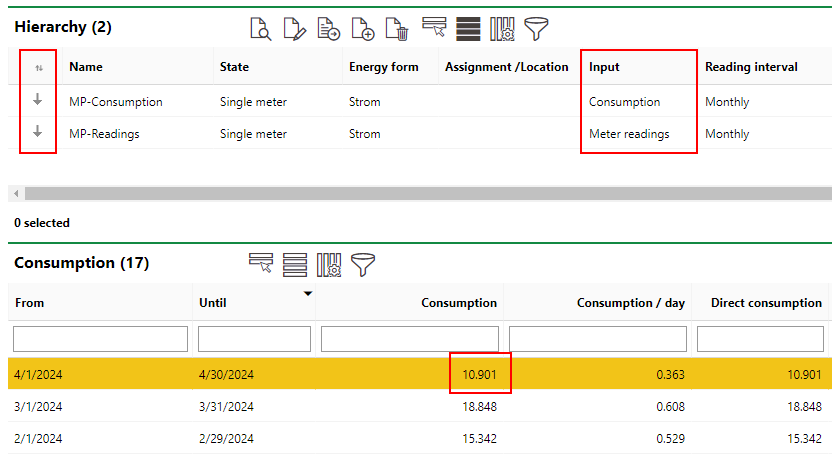
Hierarchy and Consumption Sections for Virtual Metering Point with Sum Type
Refer to Metering Point Hierarchies for information about how to create a metering point hierarchy.
With a virtual Type of Sum, the Consumption and Direct Consumption values for the virtual metering point should be the same.
The consumption entries stored in the metering point details for the subordinate metering points indicate that they consumed 5.401 kWh and 5.500 kWh in April 2024, respectively.
Consumption for First Subsidiary Metering Point |
Consumption for Second Subsidiary Metering Point |
The usage indicated in the April 2024 consumption entries for the subordinate metering points total the amount shown for April 2024 for the virtual (superior) metering point (5.401+5.500=10.901).
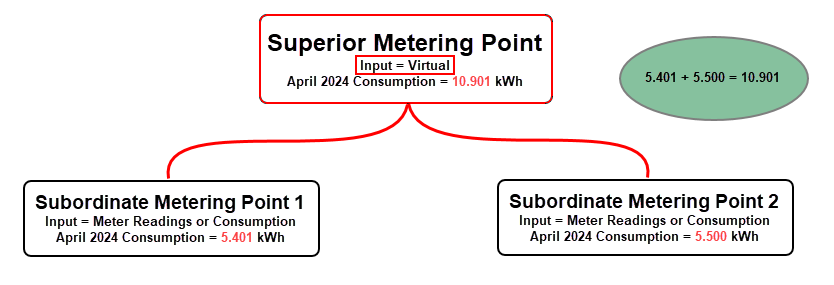
Virtual Metering Point with Sum Type Example
